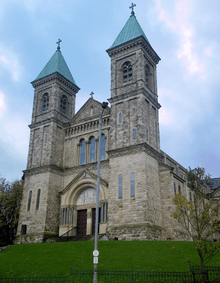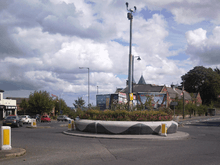Ardoyne
Coordinates: 54°36′52″N 5°57′17″W / 54.614567°N 5.954643°W
Ardoyne (from Irish Ard Eoin, meaning "Eoin's height") is a working class and mainly Catholic and Irish nationalist district in north Belfast, Northern Ireland. It gained notoriety due to the large number of incidents during "The Troubles".
Foundation
The village of Ardoyne was founded in 1815 when businessman Michael Andrews moved his Damask factory from Little York Street. In addition to the factory he built a large house for himself and thirty houses for employees to live in. More mills were built around the growing village and by 1850 there were three additional mills in the area, providing jobs and houses for a growing population.[1]
The Troubles
Crumlin Road

Ardoyne is bordered on the west by the Crumlin Road, an area which has for the most part a majority Protestant population and forms an interface area. On the Twelfth and during the rest of the marching season parades held by the Orange Order have led to conflict between the two communities. Controversy has been sparked by the differing attitudes of the two communities to the marches, with the Orange Order and their supporters arguing that they are following traditional parade routes, whilst their nationalist critics argue that the marches are triumphalist and not wanted in their area.[2][3]

For the most part the Parades Commission has given permission for the Twelfth marches to go past the flashpoint Ardoyne shops, close to the Crumlin Road roundabout which also leads on to the Woodvale Road.[4] One particular cause of conflict is that, in the past, marchers have carried flags depicting Ulster Volunteer Force and Ulster Defence Association (paramilitary terrorist organisations) banners and played loyalist songs. In 2010, however, the Shankill Star flute band was banned from carrying a controversial banner depicting UVF member Brian Robinson.[5] Another issue has been the presence and role of aggressive supporters following the march. The 2006 march agreement however determined that 'supporters' would not be allowed to march.
Since there are only two exits from the estate, residents on the opposite side of the Crumlin Road (Mountainview) are barricaded into their street by the police and Army for several hours throughout the day: in the morning when the march goes by; and in the evening when it returns. Local residents believe this to be a breach of their human rights. The Police Ombudsman concurs with this assessment but is of the opinion that the barriers are necessary for security reasons.[6]
Unionists have highlighted the part republican organisations have played in protests including prominent convicted IRA men such as Sean Kelly who was arrested after violent protests during a parade.[7]
Despite the local community group, the Ardoyne Parades Dialogue Group, and representatives of the march, the North and West Belfast Parades Forum, reaching an accommodation which imposed conditions on the march, golf balls and stones were thrown by protesters being kept back by stewards.[8] Riots that broke out following the 2010 marches were blamed by Sinn Féin's Gerry Kelly on Real IRA members orchestrating tension in the area.[9]
Holy Cross dispute
The Holy Cross Girls' School, a Catholic primary school which serves the Ardoyne area but is located in the neighbouring loyalist Upper Ardoyne/Glenbryn area was the sign of tension of 2001 to 2003. Loyalists made claims about harassment by republicans and regarding the use of the school run as a cover for IRA intelligence gathering missions, leading to crowds of protesters blocking the access of pupils to the school.[10][11] The protests, which included violence directed by loyalist protesters at parents,[12] were widely covered by the world's media and during the autumn of 2001 sparked a series of sectarian clashes in not only Ardoyne but also the interface between the loyalist Tiger's Bay area and the republican Newington and New Lodge districts.
Ardoyne's murals
Like most working class areas in Belfast, and others in the rest of Northern Ireland, Ardoyne's walls feature a number of murals related to politics and culture, although republican topics have been de-emphasised since 2009.
A mural on Ardoyne Avenue depicted victims of the famine with the legend "An Gorta Mor (The Great Hunger) – They buried us without shroud nor coffin" although this has since been removed.[13] Another depicting a mass rock is still extant on the same street, although a further mural on Ardoyne Avenue showing Cuchulainn and a hound with the legend "Ard-Eoin Fleadh Cheoil" has also been removed.[13] A mural demanding the truth about the killings of Pat Finucane and Rosemary Nelson is also gone.[13] A mural on the street recalling the Holy Cross dispute and comparing it to the Little Rock Nine is recorded by CAIN as still in existence,[14] although it too has been removed. A mural commemorating the Flight of the Earls was one of four painted in the area in 2009 to cover up those of a republican nature.[15]
A number of other murals have also been painted on nearby Berwick Road. A Sinn Féin youth emblem with demands to disband the RUC and free republican prisoners has been removed, along with a portrait of James Connolly.[13] A representation of the Virgin Mary remains in existence.[13] It is close to a mural commemorating the 1916 Easter Rising.[14]
Culture in Ardoyne
Sport
Football is a widely played and followed sport in the area. Ardoyne is close to the home ground of Irish Football League club Cliftonville, and as such the club enjoys a wide following in the area. Ardoyne itself is home to Crumlin Star F.C., an intermediate club that currently plays in Northern Amateur Football League Premier Division.[16][17] However, despite originating in Ardoyne and having their headquarters in the area they do not have a home ground locally and for the 2013–14 season play their matches at the Cliff in Larne.[17] Crumlin Star's social club is also a Celtic supporters club,[18] with the Glasgow club enjoying strong popularity in the area and amongst the nationalist community in general.
The Gaelic Athletic Association is also represented in the area through local club Ardoyne Kickhams, who are affiliated to the Antrim GAA.[19]
Music
The area is home to the annual "Ard Eoin Fleadh Cheoil" (Ardoyne Music Festival). The festival attracts some of the most famous Irish musical acts, including the Wolfe Tones.
Ardoyne in popular culture
Ardoyne is the setting in which Anna Burns' novel No Bones takes place. In this novel she describes a girl growing up in Ardoyne during the Troubles.[20]
See also
References
- ↑ Holy Cross Parish. "Parish History". Holy Cross Parish Church.
- ↑ Cracks in the Orange Order BBC News, 15 July 2008
- ↑ Loyalist parade sparks riots in Catholic area The Guardian, 13 July 2004
- ↑ Parade Will Pass Ardoyne Flashpoint
- ↑ Apprentice Boys get go-ahead for Ardoyne march
- ↑ O'Loan clears police over parade
- ↑ Collins, Tim (2006). Rules of Engagement. London: Review. pp. 67–73. ISBN 978-0-7553-1375-4. OCLC 62796448.
- ↑ Minor disturbance at Orange march
- ↑ Police force Orange Order march through Ardoyne
- ↑ Holy Cross school, Belfast: two years on, Beatrix Campbell, The Guardian, 1 December 2003, retrieved 4 August 2009
- ↑ Interface, Flashpoints in Northern Ireland, Colm Heatley, Conflict Archive on the Internet
- ↑ How my daughter was cast into a maelstrom of hatred
- ↑ 13.0 13.1 13.2 13.3 13.4 A Directory of Murals – Volume 6
- ↑ 14.0 14.1 A Directory of Murals – Album 38
- ↑ Arts Council fund Ardoyne Re-imaging
- ↑ Crumlin Star site
- ↑ 17.0 17.1 Crumlin Star at NAFL site
- ↑ Celtic Bars – B
- ↑ Ard Eoin Kickhams website
- ↑ Anna Burns: No Bones, 2001